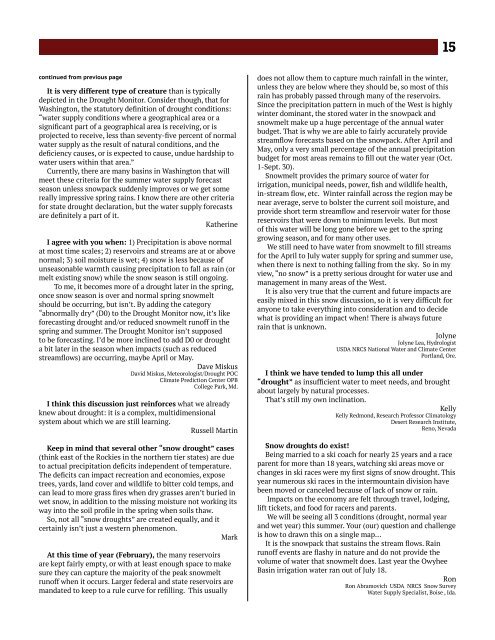April 2015 Dry Times interactive
April 2015 Dry Times interactive
April 2015 Dry Times interactive
You also want an ePaper? Increase the reach of your titles
YUMPU automatically turns print PDFs into web optimized ePapers that Google loves.
15continued from previous pageIt is very different type of creature than is typicallydepicted in the Drought Monitor. Consider though, that forWashington, the statutory definition of drought conditions:“water supply conditions where a geographical area or asignificant part of a geographical area is receiving, or isprojected to receive, less than seventy-five percent of normalwater supply as the result of natural conditions, and thedeficiency causes, or is expected to cause, undue hardship towater users within that area.”Currently, there are many basins in Washington that willmeet these criteria for the summer water supply forecastseason unless snowpack suddenly improves or we get somereally impressive spring rains. I know there are other criteriafor state drought declaration, but the water supply forecastsare definitely a part of it.KatherineI agree with you when: 1) Precipitation is above normalat most time scales; 2) reservoirs and streams are at or abovenormal; 3) soil moisture is wet; 4) snow is less because ofunseasonable warmth causing precipitation to fall as rain (ormelt existing snow) while the snow season is still ongoing.To me, it becomes more of a drought later in the spring,once snow season is over and normal spring snowmeltshould be occurring, but isn’t. By adding the category“abnormally dry” (D0) to the Drought Monitor now, it’s likeforecasting drought and/or reduced snowmelt runoff in thespring and summer. The Drought Monitor isn’t supposedto be forecasting. I’d be more inclined to add D0 or droughta bit later in the season when impacts (such as reducedstreamflows) are occurring, maybe <strong>April</strong> or May.Dave MiskusDavid Miskus, Meteorologist/Drought POCClimate Prediction Center OPBCollege Park, Md.I think this discussion just reinforces what we alreadyknew about drought: it is a complex, multidimensionalsystem about which we are still learning.Russell MartinKeep in mind that several other “snow drought” cases(think east of the Rockies in the northern tier states) are dueto actual precipitation deficits independent of temperature.The deficits can impact recreation and economies, exposetrees, yards, land cover and wildlife to bitter cold temps, andcan lead to more grass fires when dry grasses aren’t buried inwet snow, in addition to the missing moisture not working itsway into the soil profile in the spring when soils thaw.So, not all “snow droughts” are created equally, and itcertainly isn’t just a western phenomenon.MarkAt this time of year (February), the many reservoirsare kept fairly empty, or with at least enough space to makesure they can capture the majority of the peak snowmeltrunoff when it occurs. Larger federal and state reservoirs aremandated to keep to a rule curve for refilling. This usuallydoes not allow them to capture much rainfall in the winter,unless they are below where they should be, so most of thisrain has probably passed through many of the reservoirs.Since the precipitation pattern in much of the West is highlywinter dominant, the stored water in the snowpack andsnowmelt make up a huge percentage of the annual waterbudget. That is why we are able to fairly accurately providestreamflow forecasts based on the snowpack. After <strong>April</strong> andMay, only a very small percentage of the annual precipitationbudget for most areas remains to fill out the water year (Oct.1-Sept. 30).Snowmelt provides the primary source of water forirrigation, municipal needs, power, fish and wildlife health,in-stream flow, etc. Winter rainfall across the region may benear average, serve to bolster the current soil moisture, andprovide short term streamflow and reservoir water for thosereservoirs that were down to minimum levels. But mostof this water will be long gone before we get to the springgrowing season, and for many other uses.We still need to have water from snowmelt to fill streamsfor the <strong>April</strong> to July water supply for spring and summer use,when there is next to nothing falling from the sky. So in myview, “no snow” is a pretty serious drought for water use andmanagement in many areas of the West.It is also very true that the current and future impacts areeasily mixed in this snow discussion, so it is very difficult foranyone to take everything into consideration and to decidewhat is providing an impact when! There is always futurerain that is unknown.JolyneJolyne Lea, HydrologistUSDA NRCS National Water and Climate CenterPortland, Ore.I think we have tended to lump this all under“drought” as insufficient water to meet needs, and broughtabout largely by natural processes.That’s still my own inclination.KellyKelly Redmond, Research Professor ClimatologyDesert Research Institute,Reno, NevadaSnow droughts do exist!Being married to a ski coach for nearly 25 years and a raceparent for more than 18 years, watching ski areas move orchanges in ski races were my first signs of snow drought. Thisyear numerous ski races in the intermountain division havebeen moved or canceled because of lack of snow or rain.Impacts on the economy are felt through travel, lodging,lift tickets, and food for racers and parents.We will be seeing all 3 conditions (drought, normal yearand wet year) this summer. Your (our) question and challengeis how to drawn this on a single map…It is the snowpack that sustains the stream flows. Rainrunoff events are flashy in nature and do not provide thevolume of water that snowmelt does. Last year the OwyheeBasin irrigation water ran out of July 18.RonRon Abramovich USDA NRCS Snow SurveyWater Supply Specialist, Boise , Ida.


